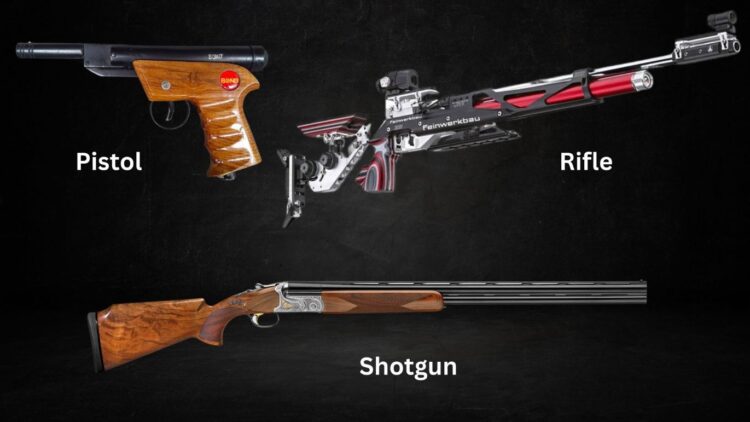
OBJECTIVE OF SHOOTING: Score as many points as possible by shooting targets with precise accuracy.
NUMBER OF PLAYERS: 1+ player(s)
MATERIALS: Firearms, ear protection, eye protection, shooting shoes, blinders, padded clothing
TYPE OF GAME: Sport
AUDIENCE: 12+
OVERVIEW OF SHOOTING
Shooting sports comprise all competitive and recreational activities that involve the accurate shooting of firearms. Similar to archery, many shooting events involve competitors firing at stationary targets in an attempt to hit the center of the target. However, some shooting events also involve firing at fast-moving targets, often in the form of clay discs.
Historically, shooting sports have existed since the invention of the firearm in the 1300s. Although shooting wasn’t exactly considered a competitive sport during this time, people honed their firearm accuracy for military training or as a means of practicing their hunting.
It didn’t take long for shooting to become a popular recreational activity, however. Swiss and German paintings from as early as 1504 depict clear examples of spectators watching people attempt to shoot at targets from a distance. Similarly, Germanic countries during this period had a wedding tradition that involved giving the hosts a wooden target that all the guests fired shots at.
Perhaps unsurprising considering this country’s immense fascination with firearms, the United States played a pivotal role in the popularity of these sports during the 1700s and 1800s. This resulted from firearms simply being a way of life on the American midwest frontier; families needed them for protection and to hunt. Not only were firearms necessary for most Americans, but they were also loved by many. Nearly every midwest village during this time hosted competitions on weekends, and soon various shooting clubs were formed in the mid-1800s, including the notable National Rifle Association (NRA) in 1871.
The modern-day popularity of shooting sports can be mainly attributed to the contributions of Pierre de Coubertin. This French historian is credited with founding the International Olympic Committee in 1894, and his personal interest in pistol shooting played a significant role in these sports being featured in the first-ever Olympics in 1896, along with other classic Olympic Games such as Cross Country Skiing. Since that year, shooting sports have been featured in all but a few Summer Olympics.
SETUP
EQUIPMENT
- Firearms: The firearms used in competitions include various variants of pistols, rifles, and shotguns.
- Ear Protection: Competitors are always encouraged to wear ear protection to minimize the hearing loss caused by the loud firing of projectiles.
- Eye Protection: Protective glasses and goggles should be worn at all times.
- Shooting Shoes: Light athletic shoes are often permitted, although specialized shoes (which usually resemble boots) with very thick soles are also worn to increase a shooter’s stability and balance while firing.
- Blinders: Blinders can be attached to a competitor’s firearm or glasses to help them focus all their attention on the target in front of them.
- Padded Clothing: Specialized extremely stiff jackets and pants are worn by many shooters to help them maintain a rigid stance when firing (natural body movements won’t impact aiming as much).
THE GUNS

There are three types of guns used in shooting sports: pistols, rifles, and shotguns. Some of these are firearms, meaning they use gunpowder, while others are air guns that use compressed air to fire projectiles that are usually smaller than those of firearms.
Pistols or handguns are designed to be fired with one hand (although two hands allow for better accuracy) and are generally only accurate in short to moderate ranges.
Rifles are long weapons designed to be held with two hands and braced against the shoulder to be shot accurately. These long guns are accurate and effective at all ranges.
Shotguns appear similar to rifles, although they fire shells containing many tiny projectiles known as shots or a single large shell known as a slug. Shotguns are typically used for short- or moderate-range targets, although this depends on the type of shells being used.
SHOOTING EVENTS
At the Olympic Games, Olympic shooting events make up a total of 15 events. These include six men’s events, six women’s events, and three mixed-team events. These events are then categorized further based on which of the three guns are used:
1) PISTOL EVENTS
- Men’s 10m air pistol
- Women’s 10m air pistol
- Mixed-team 10m air pistol
- Women’s 25m pistol
- Men’s 25m rapid-fire pistol*
*Men’s 25m rapid-fire pistol event requires competitors to shoot five adjacent targets within four seconds.
2) RIFLE EVENTS
- Men’s 10m air rifle
- Women’s 10m air rifle
- Mixed-team 10m air rifle
- Men’s three positions rifle*
- Women’s three positions rifle*
*Three position events involve a competitor taking a certain amount of shots in a standing position, a kneeling position, and a prone (lying on the stomach) position.
3) SHOTGUN EVENTS
- Men’s skeet
- Women’s skeet
- Men’s trap
- Women’s trap
- Mixed-team trap
Both skeet and trap events involve hitting clay discs that are shot out of a machine. Trap events require the shooter to hit discs that are shot away from the athlete’s direction at a variety of different angles, heights, and speeds. Skeet events require the shooter to hit two discs that are shot directly in each other’s airborne path. So, the athlete must shoot each disc as they cross the shooting area.
Pistol and Rifle events are both held in shooting ranges.
Check out some of these shooting events in action with the top 10 best moments in Olympic history:
Top 10 Shooting Moments at the Olympics | Top Moments
GAMEPLAY
SCORING
In rifle and pistol events, where the goal is to hit a bullseye target, competitors receive a certain amount of points for each shot they take. In qualifying rounds, all ten rings of the target are worth between one and ten points. During the final round, each scoring ring is subdivided into additional scoring rings. This means landing a hit in the nine-point ring can be worth anywhere between 9.1 and 9.9 points.
The number of shots each competitor takes depends on the event and whether or not it is a qualifying or finals round. In qualifying rounds, competitors have a timed shooting limit ranging from one to three hours to shoot between 40 and 120 shots depending on the event. In finals rounds, the two lowest-scoring competitors are eliminated after a certain number of shots have been taken. This continues until only two competitors remain, with the next set number of shots determining the gold medalist.
In the event of ties, officials will compare the two competitors’ qualifying round scores to determine a winner. If two competitors are still tied after this, each shot from the qualifying round is reevaluated using the ten-subdivision scoring system used in the finals.
Two other popular rifle events include Benchrest Shooting, and High Power Rifle events. There are also Practical Shooting events where competitors shoot all three firearms.

Shotgun events require each competitor to take 75 total shots spread out across three separate rounds (25 shots per round) in the qualifying stages. As there are no marked targets, scoring is as simple as whether or not the competitor was able to shoot a disc before it hits the ground. For both skeet and trap, the top-scoring competitors move on to compete in the semifinals and then medal rounds.
Skeet semifinals/medal matches consist of eight doubles being fired—that is, the competitor must try to hit 16 total discs that are shot out two at a time.
Trap semifinals/medal matches provide each shooter with 15 total targets to hit.
In the event of a tie, the competitor with the highest qualifying round score is the winner of the gold medals.
END OF GAME
The winner of a pistol or rifle event is the competitor who scores more total points than their final remaining opponent.
The winner of a shotgun event is the competitor who shoots more clay discs than their opponent.
- 30 GAMES TO PLAY OVER TEXT - April 22, 2024
- 20+ FREE PRINTABLE BABY SHOWER GAMES - April 16, 2024
- 20+ College Party Games for the Best Night Ever! - April 2, 2024